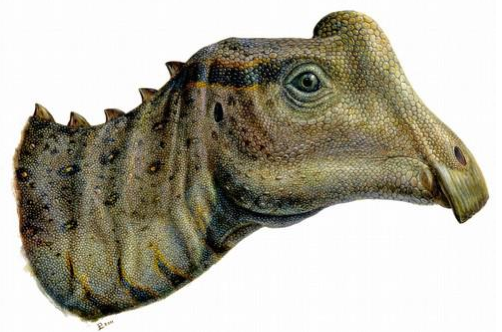Please note: Osher Rainforest will be closed for maintenance Jan. 14–16.
Science News
High School Dino Hunter
October 24, 2013
by Molly Michelson

Did you hear the one about the high school student who discovered a dinosaur fossil? It’s no joke, but rather a great demonstration of how anyone can do science!
Kevin Terris was a high school student when he discovered a fossil skeleton within Grand Staircase-Escalante National Monument in southern Utah. Incredibly, the specimen was missed by two professional paleontologists, who walked within several feet of the exposed bones days prior to the discovery.
As science writer Brian Switek writes in National Geographic, “A sharp eye and luck are still the most essential tools for dinosaur hunters.”
“At first I was interested in seeing what the initial piece of bone sticking out of the rock was,” says Terris. “When we exposed the skull, I was ecstatic!” Excavation and subsequent cleaning of the fossil, nicknamed Joe, revealed nearly the entire skeleton of a baby dinosaur measuring only six feet long.
Detailed study of Joe identified it as the most complete specimen yet known for Parasaurolophus, a duck-billed hadrosaur that lived throughout western North America around 75 million years ago. The herbivore is notable for a long and hollow bony tube on the top of its skull, which scientists speculate was used like a trumpet to blast sound for communication, as well as a billboard for visual display.
“Our baby Parasaurolophus is barely one-quarter of adult size, but it had already started growing its crest,” says scientist Andrew Farke, of the Raymond M. Alf Museum of Paleontology, who studied Joe. “This is surprising, because related dinosaurs didn't sprout their ornamentation until they were at least half-grown. Parasaurolophus had to get an early start in order to form its unique headgear.”
A sample of bone from the dinosaur's leg helped scientists estimate the animal’s age at death. “Dinosaurs have yearly growth rings in their bone tissue, like trees. But we didn’t see even one ring. That means it grew to a quarter of adult size in less than a year,” says Sarah Werning of Stony Brook University.
It seems fitting that since the fossil was discovered by a citizen scientist, it will be available for further study by scientists and non-scientists alike. The researchers have made 3D digital scans of the entire fossil freely available online. Although portions of other dinosaur fossils have been scanned and distributed in this way in the past, this the first time that virtually an entire skeleton has been posted.
The finding is published this week in the open access journal PeerJ.
Image: Lukas Panzarin